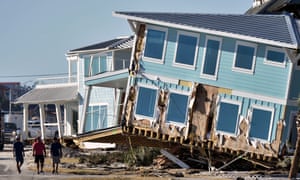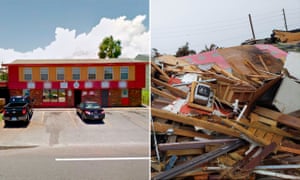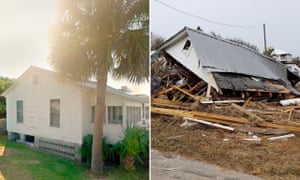Without power and living in tents: Florida Panhandle struggles after Michael
Despite best efforts of recovery workers, life is still precarious for the remaining residents of the hardest-hit coastal towns

The landscape of the cities hardest hit by Hurricane Michael looks little different than it did immediately after the storm.
Photograph: Hector Retamal/AFP/Getty Images
When Gayle Blackmon and her husband returned home to Mexico Beach, Florida, after the hurricane, discovering their old shed had survived – basically intact – was something of a twisted consolation prize.
Because their home itself, in a small condo unit, wasn’t just damaged, or even destroyed. It was gone. “It’s just a slab now, that’s all,” said Blackmon. “I mean it’s – we haven’t even found it.”
It’s been two weeks since category four Hurricane Michael slammed into the Florida Panhandle, killing at least 39 and devastating most of the region with a major storm surge from the ocean and battering 150mph winds. Despite the best efforts of recovery workers, life is still extremely precarious for the remaining residents of the hardest hit coastal towns, chiefly Panama City, Mexico Beach and Port St Joe. Amid piles of debris, the landscape looks little different from the shattered state immediately after the hurricane that made it look like a bomb had hit.
Many who have returned since the storm are living in campers, tents or bunking with neighbors, and relying on portable toilets and boxed ready-to-eat meals provided by Fema, the Red Cross or other volunteers. The schedule for the return of utilities such as electricity, gas and internet service are being measured in months, not days or weeks. Many roads are still blocked across the area, commercial services minimal to none.
But lifelong residents like Blackmon said there is nowhere they would rather be than home.
“We’re all determined. We’re absolutely going to build it back,” Blackmon said as she packed up the paltry contents retrieved from her shed into a trailer in neighboring Port St Joe.

View of the damaged caused by Hurricane Michael in Mexico Beach, Florida, three days after the storm hit the area. Photograph: Hector Retamal/AFP/Getty Images
Port St Joe and Mexico Beach sit side-by-side on the Gulf coast, seamlessly rolling into one another along Route 98 despite the fact that they don’t share a county or even the same time zone. While both were functionally demolished by Michael, Port St Joe, sitting a paltry few feet higher on a slight bluff, escaped some of the ocean storm surge that swept homes in Mexico Beach clear away. The Blackmons are waiting for a trailer from a friend that they will live out of here in Port St Joe, while they piece their lives back together. For the last few days they have been bunking on a boat that survived the storm in a canal to the north.
All over Port St Joe, thick stacks of refuse line every street. The splintered home framing, soggy tangles of insulation, home appliances and tree limbs mesh into one another more and more each day as they settle. Homes that haven’t outright collapsed are missing roofs, dormers and balconies. Dumpsters overflow with trash, as sanitation workers have been unable to collect it. The flashing yellow lights of utility trucks are omnipresent and start to drift into background noise before long.
One utility linesman, Rick, descends from his cherry-picker, pulls the pop-top off a can of beans and sucks it down cold before cracking into a container of applesauce. “16-hour days” he says, unprompted. “At least 16 hours.”
He’s in from Oklahoma, like most of the crews working in this particular part of town, and says he has no idea how long before he’s able to go home. “‘Till it’s done I guess,” he said with a casual shrug.
A few roads up from where the Blackmons are trying to plan their next steps, three more locals, David Weber, Julia Ferrell and Al Burnett, sit under a portable awning at what looks like a cross between a campsite and the pantry of a youth camp. There are coolers, bins and baskets of packaged foods such as crackers, cookies and stacks of bottled water all around. Ferrell has been cooking for neighbors on a portable Coleman gas stove for the last week, her way of staying busy. “We have no TV, we have no news. We don’t know what’s going on,” Ferrell said. Cellular service was absent for over a week. Now it’s spotty.
The local bar the three used to frequent, the Lookout Lounge, is within sight of here but completely crumbled to the earth. The bottom of a sink and the corner of a no smoking sign peek out from the rubble.

The Lookout Lounge in 2011 via Google Street View, and its destroyed remains after Hurricane Michael. The bar sits right on the dividing line between Port St Joe and Mexico Beach. Composite: Jamiles Lartey for the Guardian/Google
Burnett laments that due to the storm he is both homeless and unemployed. His work at nearby Tyndall air force base has completely stalled and he says after his sick time and vacation days are exhausted he expects to be put on unpaid furlough. There are whispers around the base that it will be years before things are back to normal, though some rebuilding kicked off on Wednesday.
Right now he’s staying a couple of miles up the road with Weber in his only partially habitable home in the hamlet of Overstreet, where the damage is comparable but where residents say the response from the authorities and NGOs hasn’t been nearly as robust as the hurricane’s initial bullseye. “There hasn’t been anyone that way. No electrical. No emergency crews. Nothing,” Burnett said.
“The people that live inland off these Florida roads, they’re not seeing what we’re getting down here [at the coast] and that’s wrong.”
That’s a fair way to describe the situation for Blountstown resident Mike Spitzer who describes weathering the storm in this rural area as he tends to a makeshift roast he’s cooking on a woodstove out front of his home.
“We didn’t think we’d make it,” Spitzer said “I’m a Vietnam vet – I thought I’d seen everything. I’d rather have been out in the jungle getting shot than what we went through.”
He is living in the remains of his home, but brought the solid iron woodstove outside over concerns that his chimney might be damaged from the storm. The last thing he needed was a fire or backup of smoke.
His wispy salt and pepper hair is stuck to his face with sweat on a cool, grey afternoon. He said he hasn’t stopped working and hasn’t slept much since the storm, clearing up almost nonstop. “If you get a few hours’ sleep here and there you’re lucky. I haven’t stopped in two weeks. I’m exhausted.”
The face is ripped off his home, as are big chunks of the ceiling, exposing the lumber frame. He said so many trees came down during the storm that “it looked like a jungle – you couldn’t crawl through it.” It took him more than a day just to saw his way to the road, at which point his chainsaw promptly gave up and died.

A destroyed home along highway 98 in Port St Joe, and the home as it looked in 2015 via Google Street View. Composite: Jamiles Lartey for the Guardian/Google
In his yard there is a completely flattened trailer home, and an RV with at least four trees still sitting on it. There are copious stacks of sawed logs everywhere, and big piles of rubbish including Spitzer’s mattress, a TV and other interior odds and ends that the storm wrecked.
With hands on his hips, Spitzer’s lips curl as he surveys the newly sparse tree line. Homes can be rebuilt he points out, but the kind of tall pines that Michael razed like matchsticks don’t come back so fast. He’s drawing water from his damaged well. Few in these parts have running water right now.
Back in Port St Joe, Burnett rued: “This landscape is going to be changed forever. For lack of a better term, desolate,” he said.
“My best educated guess is that things will never be right for maybe the next three or four years … maybe never.”

Recent Comments